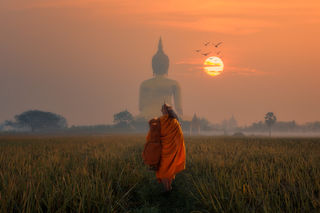Spirituality
Women’s Roles and Influences in the Life of the Buddha
Women’s Roles and Influences in the Life of the Buddha
Posted February 25, 2012

When we contemplate truly great figures in the course of human history, two names often come to mind: Jesus and Buddha. Both are historical figures shrouded in legend. Both possessed such love, consciousness, and universal wisdom that they are worshiped as divinity. There are significant differences, however, in how both history and legend represent the roles of women in their lives. Some scholars and popular authors assert that significant roles women played during Jesus’ life were marginalized, and in some cases entirely erased by later historians. The historical life of the Buddha, however, suffers far less such inadequacies. Hundreds of ancient Buddhist texts in Pali, Sanskrit, and Chinese describe in vivid detail the prominent roles various women played in the Buddha’s life, including how feminism played an important role as part of the social reforms sought by the Buddha.
This paper attempts to conduct a brief survey of the key roles a number of women played in Buddha’s life and his building of a religious community, including accounts of the Buddha’s early family life, his dilemma in admitting women into the community, how women gained leadership and thrived in his community in spite of gender prejudice, why the Buddha ultimately failed in his reforms, and finally how vestiges of these historical events can still be observed today in Buddhist monastic practices.
Roles of Women in the Early Life of the Buddha: A Higher Form of Love
It is said that “behind every great man is a great woman”. In the case of the Buddha, he had two great women in his early years that supported his decision to find the Great Way: his step-mother Gotami, and his wife Yasodhara.
Before he attained enlightenment and became the Buddha, Prince Siddhartha Gautama was born around 563 B.C. The eldest son of a royal family, Prince Gautama was groomed to become king from day one. Legend has it that the royal astronomer predicted before Prince Gautama’s birth that he was either to be a great king or abandon politics and be a great social and spiritual reformer. Fearing the latter, Prince Gautama’s father, the King Suddhohana, exercised great care to shield the young prince from witnessing the sufferings of the world. Queen Gotami, although not Prince Gautama’s birth mother, cared for and loved the prince as her own. As Prince Gautama approached his teens, wine, women, and song were poured upon him to keep his attention away from the troubles of the world. It was at a gathering where the young prince was introduced to over one-hundred young, noble, and single women when he met the attractive and elegant Yasodora. The two took a liking to each other immediately and married shortly after. Yasodora bore Prince Gautama a son, named Rahula.
At this point, King Suddhohana had good reason to believe his plan to keep Prince Gautama focused on family life and to one day for him to become king had succeeded. Unbeknownst to the king, however, Prince Gautama was already harboring thoughts of leaving the kingdom to seek the Great Truth. In this he was encouraged and supported, directly and indirectly, by both Queen Gotami, and Yasodhara. Both of these women possessed uncommon strength and compassion, and both saw early on that Gautama’s true destiny was not in politics, but spiritual enlightenment. A well known Buddhist story recounts how one day, while on an outing in a horse carriage, Prince Gautama and Yasodhara saw a deathly ill man lying on the side of the road. Both Gautama and Yasodhara got off the carriage to help, and both were terribly disturbed by what they saw. In subsequent conversations, Gautama would express more and more his desire to embark on a path to find the Great Truth and alleviate the sufferings of the world. Yasodhara, being more practical, would focus on how the poorest members of society could be helped at the moment. The night when Prince Gautama was to secretly leave the kingdom and embark on his spiritual path, Queen Gotami knew about his plans but did not alert the king. Yasodhara pretended to be asleep for fear that she might become too upset and try to stop her husband. She left his travel necessities on the table for the journey.
The author of this paper once met a Buddhist monk and a nun who were a romantic couple before becoming students of Buddhism and ordained as monastics. I asked them separately how they could stand to “break up” to become a nun and a monk. Their similar answers both surprised and impressed me. They both said, in effect, that while they still loved each other, by becoming monastics they could expand that love and share it with the world. Both Gotami and Yasodhara possessed such higher forms of love. They both loved Prince Gautama dearly and were sad to let him go on a personal level. But they both loved Gautama too much to stop his path, or what he intended to do to help humankind. Years later, after the Buddha attained enlightenment and began spreading his message throughout India, Gotami would be instrumental in helping the Buddha ignite one of the most daring social reforms of their time: allowing women to enter the religious order, and onto the path toward personal liberation and spiritual enlightenment.

Buddha the Reformer: Lowering Caste and Gender Discrimination
With his upbringing as a royal prince, Siddhartha Gautama was deeply versed in ancient Hindu texts and religious practices. He felt dissatisfied with how the dominant religion of his day was in the exclusive domain of an elite class, and how this class, the Brahmans, claimed sole proprietorship to religious authority, salvation, and enlightenment. After he attained the Great Awakening, Gautama, now known as the Buddha, sought to bring equity to the domain of spiritual practice. The Buddha’s religious movement was not an attempt at breaking with Hinduism, but rather reforming what he viewed were the ills of Hinduism and Indian society in general. Two of these major ills were caste and gender discrimination. As a reformer, the Buddha’s most notable acts were admitting untouchables and women into his religious community.
The move to accept untouchables came first. The Buddha was clear early on that acceptance of the lowest caste members was a matter of course. In a famous story, the Buddha began this social revolution by stepping into a river with the untouchable night soil carrier Sunita. Recognizing the seeds of enlightenment in Sunita, the Buddha asked the untouchable if he would like to join the spiritual community. When Sunita agreed, the Buddha bathed him, shaved his head, and ordained him on the spot, in full view of his disciples and nearby villagers. Sunita went on to become a highly respected monk known for his spiritual clarity and wisdom. Predictably, there was an uproar of the Buddha’s action from the upper casts of society. The Brahman elite accused the Buddha of attempting a revolution to overthrow the existing order. Royal patrons (including Buddha’s father King Suddhohana) questioned his motives and intentions. But for as long as the Buddha lived, untouchables practiced in his community side by side with all others.
The move to allow women into the community was for the Buddha an even more daunting task. Having experienced the backlash against admitting untouchables, the Buddha was unsure how to accept women into the religious order without further uproar, and possibly fracturing the community. Ancient Buddhist texts offer examples of the Buddha giving teaching and guidance to laywomen, only to reject their requests to be ordained on the grounds that the time was not yet ripe to accept women.
It took someone of Queen Gotami’s stature to convince the Buddha otherwise. For many years, Gotami, Yasodhara, and many other women practiced the Buddha’s teaching as lay disciples with the intention to be ordained as nuns.
Determined to gain acceptance into the monastic order, Gotami and a group of women shaved their heads, gave away their possessions, and walked barefoot for fifteen days (begging for food along the way) to the Buddha’s community. They were determined to show that women, like men, could successfully live and practice as monastics.
Informed of the women’s arrival and their intention, the Buddha was still hesitant. Referring to the writings of Thich Nhat Hanh, the Buddha and his attendant Ananda had the following exchange, where Ananda raises the question of whether women can achieve the various levels of mindfulness and enlightenment:
Ananda: “Lord, is it possible for a woman to attain the Fruits of Stream Enterer, Once-Returner, Never-Returner, and Arhatship?”
Buddha: “Without a doubt.”
Ananda: “Then why won’t you accept women into the Sangha?”
The Buddha went on to explain that it wasn’t discrimination, but concern over fractures in the religious community, which kept him from admitting women. As the story went, a meeting was called among the Buddha’s most senior disciples, during which the Buddha explained his concerns, and sought their input.
Sariputta, the Buddha’s most senior disciple, suggested that women could be admitted into the community, but under eight conditions, including:
Rule #1: A bhikkuni (nun) will always defer to a bhikkhu (monk), no matter how senior the bhikkuni is or how novice the bhikkhu is.
Rule #7: A bhikkuni is not allowed to criticize a bhikkhu.
Rule #8: A bhikkuni is not allowed to instruct a bhikku, although a bhikkhu is allowed to teach a bhikkuni.
When another senior disciple objected to these conditions on the grounds that they’re clearly discriminatory, Sariputta retorted that the rules are meant to open the path to admit women without fracturing the religious community, or causing backlash from society. The senior disciples agreed with the Buddha’s consent, and 51 women, including Gotami, were ordained that day.
Once women (including untouchable women) were admitted into the Buddha’s religious community, they quickly showed their aptitude as monastics. Buddhists texts contain many examples of Buddhist nuns successful in their practice and leadership. Some nuns, such as Bhikkhuni Mahapajapati, initiated building convents and became leaders of female religious communities. Bhikkhuni Khammadinna’s understanding of the Buddha’s teachings was so profound that the Buddha asked her interpretation to be repeated by senior monks to the entire community (note both adherence and side-stepping of the aforementioned Rule #8). Bikkhuni Patacara contributed beautiful poetry and verse to the spiritual practice.
Unfortunately, Sariputta’s rules, which were meant at the time as a temporary measure, become institutionalized and remain to this day.

Buddha the Failed Reformer
Should the Buddha have admitted women without pre-condition, as he did with the untouchables? Would full and unconditional acceptance of women into the religious order during the time of the Buddha have helped subsequent generations of women achieve greater equality, or cause a backlash so severe that it would, as the Buddha feared, fracture the religious order? Answers to these questions are at best speculative. What we know for certain is that the Buddha, while spectacularly successful as the founder of one of the world’s greatest religions, failed in his role as a social reformer. After the Buddha’s death in 483 BC, the practice of Buddhism as a religion, and the preservation, study, and dissemination of Buddhist texts became increasingly the exclusive domain of monks, to the exclusion of nuns and laypersons alike. As Buddhism became less accessible to the masses in India, its prominence and influence declined. By the time the Muslims conquest in 1192 AD, the practice of Buddhism all but ceased to exist in India, gone with it the brief progress that was made in gender and caste equality.
Empowered but Not Equal: Vestiges of the Feminist Revolution in a Buddhist Community Today
While Buddhism faded in India, it nevertheless spread throughout Asia and eventually to the West. Vestiges of both the gender equality reform and compromise from the time of the Buddha can still be seen in some Buddhist communities today. The author of this paper once attended a Buddhist retreat, where dozens of monks and nuns were present. There were ample opportunities to observe the social dynamics of this particular monastic order. Curiously, this community preserved both characteristics of female empowerment and discrimination in its traditions, much like the time of the Buddha 2,700 years ago. The religious order had just opened a new center, and a senior nun, not a monk, was designated as the head abbess of the center which provided services to both women and men. However, during meal times, all the monks were given food first, in order of seniority by ordination, followed by all the nuns, also in order of seniority by ordination. The head abbess of the new center, therefore, with her over twenty years of seniority, still had to line up and wait to receive her food behind the most novice monk. This was a peculiar reflection of gender inequality which did not go unnoticed by some of the retreat participants.
Download Free excerpts of my publications on personal and professional success (click on titles):
"How to Communicate Effectively and Handle Difficult People"
"Are You Highly Sensitive? How to Gain Immunity, Peace, and Self-Mastery!"
"How to Let Go of Negative Thoughts & Emotions – A Practical Guide"
"Confident Communication for Female Professionals"
Follow me on Twitter and Facebook!
© 2008, 2012 by Preston C. Ni. All rights reserved worldwide. Copyright violation may subject the violator to legal prosecution.
References
Books
Fischer, Louis. The Life of Mahatma Gandhi. New York: Harper & Row, 1950.
Smith, Houston. The World’s Religions. New York: Harper Collins, 1991.
Thich, Nhat Hanh. The Path of Emancipation. Berkeley: Parallax Press, 2000.
Thich, Nhat Hanh. Old Path White Clouds. Berkeley: Parallax Press, 1991.
Web Sites
Buddhism: The Decline in India.
<http://www.wsu.edu:8080/~dee/BUDDHISM/DECLINE.HTM>
Gautama Buddha.




